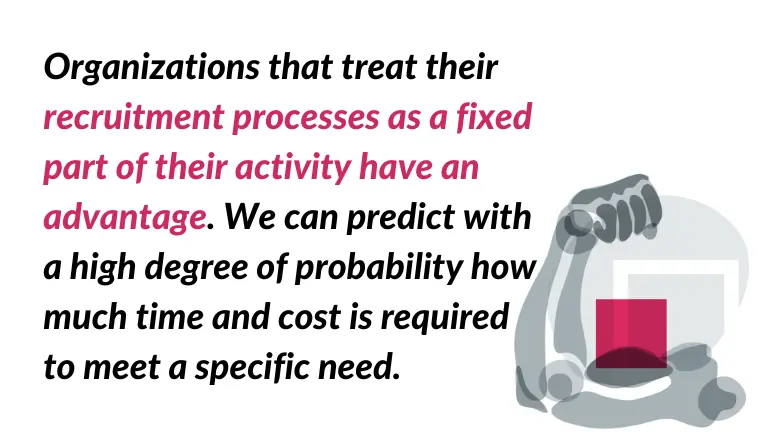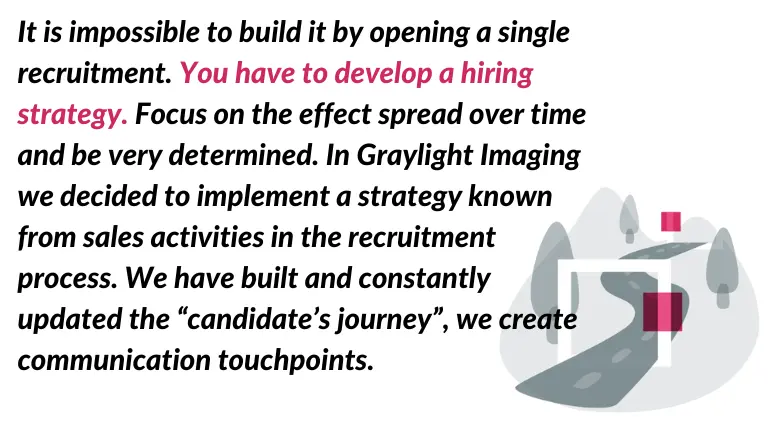Mission: to recruit programmers
While thinking of this post on how to recruit programmers I was reading the report presented on the Devskiller portal “The average time to hire varies and according to some research it takes as long as 95 days. (…) The average sunk-cost of a new hire is somewhere between $4,325 (Deloitte 2015) and $41,111 (£31,808 Oxford Economics 2014). For a position with a salary of $51,676 (£40 000, Quarsh) the number goes up to $89,510 (£69,285, Quarsh). (Source)
Evans Data Corporation recently announced the results for their Global Developer Population and Demographic Study 2019, which suggests that there are currently 23.9 million developers worldwide. However, it doesn’t mean that the market is saturated at all.
Today there are an estimated 600,000 tech vacancies in the UK, which is predicted to jump to 1 million by 2020. This number of vacancies is 5 times larger than any other industry and is costing the UK economy an estimated £63 billion a year in lost additional GDP. (Source)
Of course – the cost and time needed to recruit a new software engineer varies from region to region, or even moment to moment
throughout the year, but being close to this market, we see some constants. I would like to share our experiences in the following post.
IT talent pool
It may seem obvious that the most time-consuming part of the recruitment process is the process of harvesting talent from the market. However, this is an irrefutable truth – smaller companies as well as established organizations face this problem. The moment of gaining the interest of candidates is also critical if we consider the conversion of the recruitment process. According to our data, the conversion of the recruitment process consists of up to 50 people who need to be contacted in order to meet one competence demand. I mention the data for good reason – they are of paramount importance in our process.
Data-driven recruitment
As a company with almost 20 years of experience in attracting and hiring IT talent, we strive to make the most of the data we have. In saying this, I am aware of a certain flaw in the wording. The recruitment process is a process in which each component is sensitive. The recruiter, as well as the candidate (developer or QA) and the manager who proposes the need for competence, are human. The success of the whole undertaking depends largely on the dynamics of these individuals.
However, this does not mean that a data-driven approach is not completely impossible to apply here. First of all, historical data allows us to make predictions. Here, indeed, organizations that treat their recruitment processes as a fixed part of their activity have an advantage. We can predict with a high degree of probability how much time and cost is required to meet a specific need and recruit programmers. This is different when recruiting engineers working in .NET. Different when we are looking for a specialist with a very niche scope. Even more so when it comes to specialization in machine learning. Since we have been employing more than several dozen people annually for years, we have the data that allows us to realistically plan the launch of a project. What is additionally important – we do not have to “waste” time on rolling out of online recruitment.

To recruit programmers – what’s eating the money?
We know that a campaign launched “from scratch” takes up to a month to start producing results. We know that a campaign launched “from scratch” takes up to a month to start producing results. And this is only the beginning of the road. It should be remembered that the cost of acquiring an employee is not only the cost of the recruiter’s working time, head hunter or paid digital campaign. But also the time of the manager who participates in such a recruitment. Moreover, technical recruiters who verify the competences of the candidate. And the rest: the cost of lost profits. On the one hand, the start of a new project is dragging on. While on the other hand, people involved in the ongoing recruitment have to share their responsibilities. Reducing effectiveness in other areas or projects.
Time devoted by a manager (spent on the recruitment process, reviewing CVs, interviewing and repeating the process if the job offer gets rejected) with a $62,000 salary (according to PayScale) for 10 days costs 2 818 $ of their time and 8 454 $ in terms of productivity loss. (Source)
Candidate’s Journey?
If our campaign is a success and we are flooded with an avalanche of CVs, we have to find the perfect candidate (employee) among these offers. Some time ago, springing like mushrooms after the rain, new companies appeared on the market offering several weeks of bootcamps. Enabling a relatively quick retraining from another profession to the area of software development. It seemed that this would help to satisfy the market demand. Today we find ourselves in a different reality. The market is overwhelmed by candidates starting “from scratch”. The number of 600,000 tech vacancies in the UK mentioned in my introduction mainly concerns experienced workers. How do you find them?
While speaking of how to recruit programmers in the IT industry, the recognition of the employer’s brand. Moreover, the context in which it occurs is difficult to overestimate. In my opinion, it is impossible to build it by opening a single recruitment. You have to develop a hiring strategy. Focus on the effect spread over time and be very determined. In Graylight Imaging we decided to implement a strategy known from sales activities in the recruitment process. We have built and constantly updated the “candidate’s journey”, we create communication touchpoints, we run our services, we are present at the most important industry events, we organize our meetings, and we take care of the consistency and authenticity of our employer’s brand. Also in communication. We are where we can meet developers and QA.

One of the elements of the recruitment campaign, aimed at specialists in medical imaging analysis
An example of a film promoting a campaign to recruit programmers specializing in video analysis and Big Data:
To recruit programmers – sad reflection?
At the very end, I would like to share, perhaps, a seemingly sad, statement. The truth is that in order to meet with interest you have to catch the right moment – the moment when the person is actually considering a change of job, otherwise even the most meticulously planned actions will burn down. Preferably, at this very moment the candidate should remember about our company in a positive light. Continuous presence in the industry space and in the awareness of the IT community helps a lot, although it requires a lot of effort and determination. However, the consistency of conducted activities brings very tangible results – there is no greater satisfaction for a recruiter than hiring the right, culturally aligned person.
Contact us if you have any questions!
See the previous post: IT project estimation – what is worth remembering?